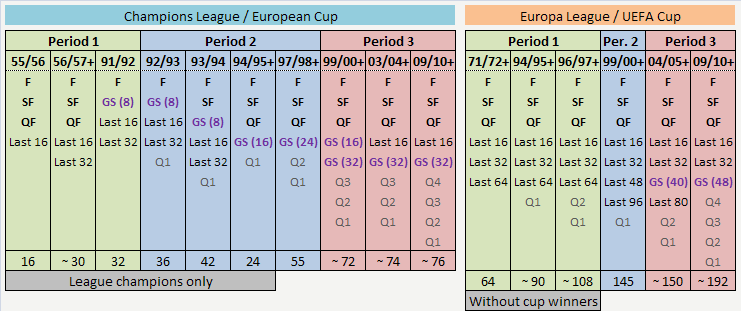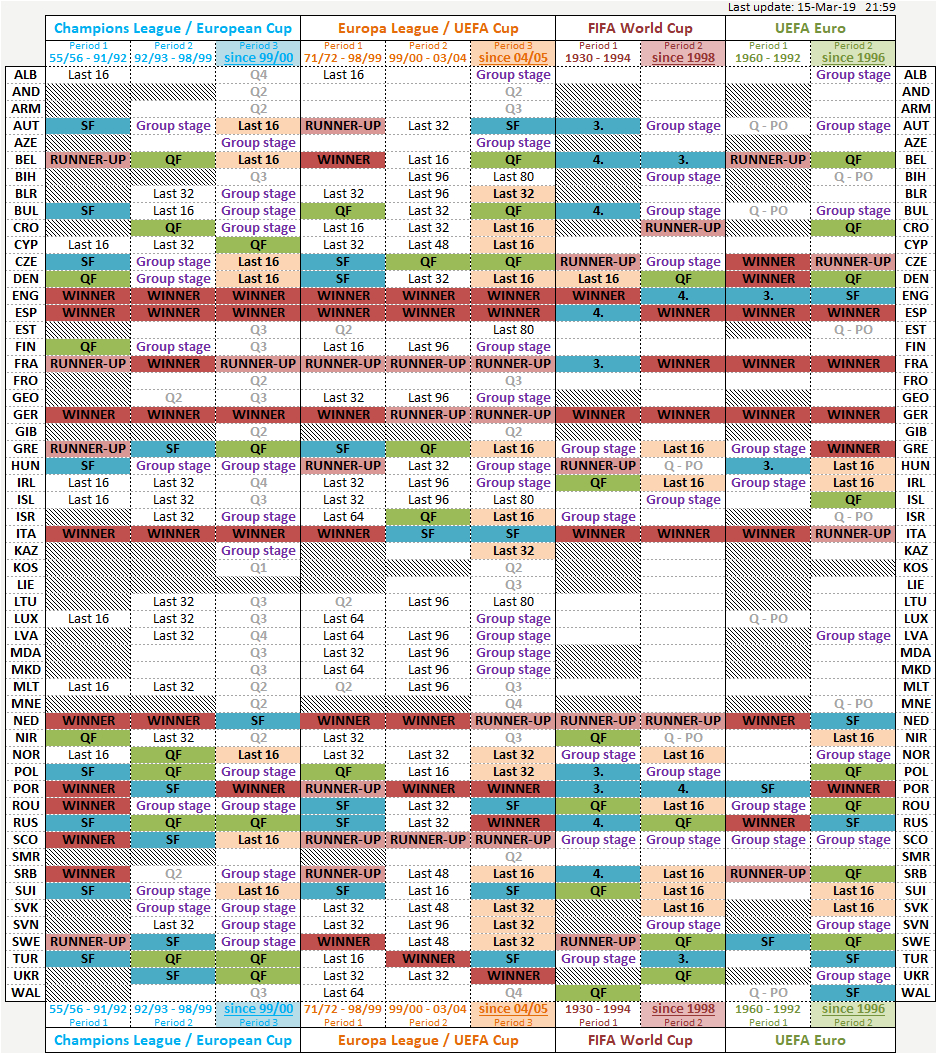Country overview
Country overview shows basic informations about all UEFA members - best historical results in Champions League, Europa League, World Cup and Euro, or historical charts of UEFA Country Ranking and National Ranking UEFA.
Introduction
Historical results - club football
Historical results of UEFA Champions League / European Cup are divided into 3 periods: 3) Since 1999/2000 (current Champions League era with three or four qualifying rounds and Group stage with 32 teams); 2) 1992/1993 - 1998/1999 (first seasons of Champions League era with introduction of Group stage - sometimes with 8, 16 or 24 teams); 1) 1955/1956 - 1991/1992 (era known as European Cup, always played under KO system - except season 91/92).
Historical results of UEFA Europa League / UEFA Cup are also divided into 3 periods: 3) Since 2004/2005 (current system with three or four KO rounds before start of Group stage with 40 or 48 teams); 2) 1999/2000 - 2003/2004 (Cup Winners' Cup is abolished and all domestic cup winners qualify for UEFA Cup, which is played only under KO system); 1) 1971/1972 - 1998/1999 (old era of UEFA Cup - without domestic cup winners, also only under KO system).
Competitions are divided into 3 periods due opportunity to make better comparison between achieved results. For example best Albanian result in Champions League / European Cup is participation among last 16. But this result has been achieved in period 1 (1956 - 1992), when reaching the last 16 has required only one winning tie. On the other hand - KF Skënderbeu didn't qualify for main phase of Champions League in 2015/16, but their reaching of 4th qualifying round has required more winning ties than mentioned participation among last 16 in former European Cup. Following table shows formats and approx. number of teams in all periods (rare preliminary rounds with just few teams aren't listed).

How to read historical results? For example "1971/1972 - 1998/1999: Last 16 - KS Flamurtari (88)" indicates that best result of any Albanian club in UEFA Cup between years 72-99 was KS Flamurtari's participation among last 16 teams in season 1987/1988.
Historical results - international football
Also historical results of FIFA World Cup and UEFA Euro are divided into more periods. FIFA World Cup periods: 2) World Cups since 1998 (current format of final tournament with 32 teams and qualification with approximately 50 members of UEFA / 200 members of FIFA); 1) World Cups 1930 - 1994 (16 or 24 teams in final tournament, usually every third European team could qualify from qualification because less number of UEFA members and relatively high number of WC spots reserved for Europe - due few contenders from rest continents). UEFA Euro periods: 2) Euros since 1996 (current format of final tournament with 16 or 24 teams); 1) Euros 1960 - 1992 (final tournaments with only 4 or 8 teams).
Charts of Country Ranking and National Ranking
Charts of UEFA Country Ranking and National Ranking UEFA currently shows only coefficients since 2000 because results from preceding years are not too much comparable especially due dissolutions (Czechoslovakia, Soviet Union, Yugoslavia) in 1990s, which meant affiliation of nearly 20 new UEFA members. Of course, these dissolutions were also one of the reasons, why historical results were divided into more periods.
Country overviews
Click on requested country to see details.
Albania, Andorra, Armenia, Austria, Azerbaijan, Belarus, Belgium, Bosnia and Herzegovina, Bulgaria, Croatia, Cyprus, Czech Republic, Denmark, England, Estonia, Faroe Islands, Finland, France, Georgia, Germany, Gibraltar, Greece, Hungary, Iceland, Israel, Italy, Kazakhstan, Kosovo, Latvia, Liechtenstein, Lithuania, Luxembourg, Macedonia, Malta, Moldova, Montenegro, Netherlands, Northern Ireland, Norway, Poland, Portugal, Republic of Ireland, Romania, Russia, San Marino, Scotland, Serbia, Slovakia, Slovenia, Spain, Sweden, Switzerland, Turkey, Ukraine, Wales.
Summary of Country overview
Following table shows summary of best historical results of all UEFA members in all mentioned competitions and periods. For details click on requested country above.
Red color - finalists; blue - semifinalists; green - quarterfinalists; orange - given team has advanced from Group stage; Q - PO indicates qualifying play-offs; empty fields - never advanced from first qualifying round; shaded fields - did not participate in given competition.
